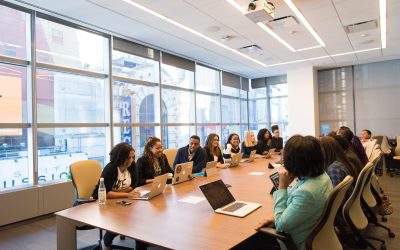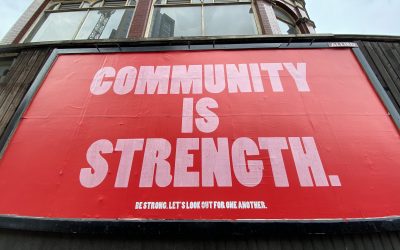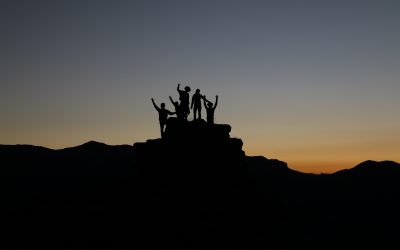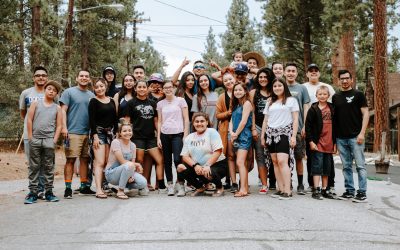*With many of you folks who read my blog having an active interest in participating or growing a community of some sort, I am going to re-print some portions of my book, [The Art of Community](https://www.artofcommunityonline.org) on my blog. I would feel guilty about doing this if it weren’t for the fact that the book is entirely free and [available for download](https://www.artofcommunityonline.org/get/), although if you can afford to, do [buy a copy so you can to support O’Reilly in publishing Creative Commons books](https://www.artofcommunityonline.org/get/)*.
*This fragment is right at the beginning of chapter one, and starts covering some of the underlying social elements about how community works. The book then delves into the practical elements of growing community later*.
> “Great things are not done by impulse, but by a series of small
things brought together.” — Vincent Van Gogh
As my watch ticked over to 8pm, I knew I was in trouble. First of all, I was late, and not fashionably late, either. In fact, at the time, I was about as unfashionable as you could get for someone staring 18 down the barrel. Long hair, Iron Maiden t-shirt, baggy camouflage trousers, and a thumping-great leather jacket. I left my parents’ house and got into my small van, adorned with oversized speakers and a tree-shaped air freshener. It was time to roll. “Rolling” was optimistic. Instead, I sat bumper-to-bumper in traffic with half of Southern England, all joined in curiosity about whether or not that film with Michael Douglas could become a reality on this cold English day.
This wasn’t helping my nerves. As a fairly outgoing, angsty teen, nerves were not usually my bag, but tonight, I was dining on them.
You see, tonight was different. Tonight I was doing something unusual, something that had seemed like a great idea…when I wasn’t running 30 minutes late, hammering my way down the motorway, with my Number of the Beast cassette ritualistically sacrificed to the gods of hi-fi just for good measure.
Thankfully, the world’s longest mechanical conga line decided to crank it up a notch. Before I knew it, I found myself on a street I had never been to, in a city I had never been to, about to head into a room full of people I had never met before, all united by one simple symbol….
A penguin.
An hour before, that penguin had seemed so inviting and friendly. It was a symbol that encompassed everything about the movement it represented, a movement that came together
in spirit and mind to build a system that drove a new generation of technology and freedom…a movement that celebrated this drive by forming user groups in unknown streets, in unknown cities, and with unknown people.
But as I stood there, doorbell already pressed, none of that was even close to my conscious thoughts. Instead, the brain of one Jonathan E J Bacon was battening down the hatches, preparing for ultimate, unparalleled discomfort as I walked into a place I both did and didn’t want to be at the same time.
Then, the door opened and a rather nice chap called Neil welcomed me into his home.
Community is a funny beast. Most people—the kind who watch talent shows on television and occasionally dip bread in oil in an expensive restaurant—don’t understand people like
Neil. Why on earth would this guy decide to open his home, free of charge, to a collection of strangers who met on the Internet? Why would he want to spend an evening drinking tea and making jokes about something called “Emacs”? And why would he fund online resources like fliers, a mailing list, and a website from his own pocket; start a book-lending service for the group—and even shell out for tea and biscuits?
One person who really didn’t seem to understand was Neil’s wife. Somewhat bemused, and referring to us as his “Internet friends,” Neil’s significant other decided tonight was the night for visiting a long-lost (or possibly ignored) relative, rather than sticking around and faking interest.
## Collaboration-Driven Ethos
What intrigued me when I first walked into Neil’s living room was the concept of a collaboration-driven ethos, although at the time I had no idea what those words meant. What
that experience taught, and what that evening inspired in me, was an excitement about what is possible when you get a group of people together who share a common ethos and a
commitment to furthering it.
In my world, that ethos has thus far been Free Culture, Free Software, digital rights, and breaking down the digital divide, but it can be as critical as creating world peace or as fanciful as sharing photos of kittens playing guitars on the Internet. The importance of community is not in the crusade, but in how you unify people to march forward together, side by side. At its heart, The Art of Community is a distilled set of approaches and thoughts about how to build community. The book is a collection of experiences, observations, and thoughts from my career and elsewhere. My aim is to bring this grab bag of concepts and curiosities together into one consistent text.
However, it is important that we keep the book in perspective in the wider scheme of your growth as a community leader and organizer. You should mentally frame the content here as a foundation for your own ideas, but remember that practical experience is the real magic that we want to create, with theory merely the glittery jacket and spinning bow tie. Community is fundamentally a soft science. Compare it with, for example, programming. If you want to write a computer software application, you write it in a programming language. These synthetic languages are vessels of logic. They live and breathe in a world where the answer to a question is either yes or no ; there is no maybe. In a world where maybe does not exist, you can plan ahead for an answer. With community, the importance and diversity of the question is equally essential.
But Neil is not unusual. At least, not in the Open Source, Free Software, Libre, and Free Culture world. There are many Neils all over the globe, organizing groups, setting up mailing lists, scheduling meetings, and coming together to share an ethos : the combined set of beliefs, customs, and sentiment that flows between like-minded people.
In the last 10 to 15 years, we have seen Free Culture in technology, art, and media explode into our consciousnesses. The entire machine is driven by people like Neil: people who volunteer themselves to the concepts of community and togetherness wrapped around such an ethos.
There are Neils outside the Free Culture world, too. They’re in church groups, helping the poor and unfortunate; in Neighborhood Watch and Meals on Wheels campaigns, reaching out to those around them; and in public art installations, political groups, and craft fairs. They volunteer, perform, and share their opinions and creativity on anything from aerobics to knitting to yoga.
## The Essence of Community
On February 26, 2004, three friends and I released the first episode of a new audio show called [LugRadio](https://www.lugradio.org/). Although LugRadio will be featured extensively in this book as a source of stories, all you really need to know about it right now is that (a) it was a loose and fun audio show (a podcast) about open source and free culture, (b) on that day it was entirely new, and (c) we had absolutely no idea what on earth we were doing. Radio personalities across the world were not exactly shaking in their boots.
Recorded in a very small room that I called a studio, but was actually a bedroom filled with secondhand recording equipment, LugRadio involved my three compadres and me opining into four precariously balanced microphones that fed into a computer. Episode 1 was around half an hour long, composed of bad jokes and a book review, and totally unpolished. At the time, it was just new and different. (Little did we know that four years later we would wrap up the show having achieved over two million downloads.) Anyway, enough of the self-congratulatory back-patting and back to the story….
With the show out, we did what many of us in the open source world do—we set up forums, wikis, and channels, and tried to get people together around our new project. The forums went online first, and people started joining.
The 22nd member was a guy called Ben Thorp, known as mrben on the forums. An Englishman living in Scotland, mrben was an open source enthusiast who stumbled onto the forums,
listened to the show, and liked what he heard. For the four years that LugRadio lasted, mrben was there every single day: in total contributing over 3,000 posts; involving himself in the chat channel, the wiki, and the organization of the live events; running an episode download mirror; and much more. mrben was there every step of the way, loving every second of it.
The first question is—why? Why does a 30-something Engli-Scot decide to immerse himself so deeply in a group of people he has never met before? What is it that makes him want to spend time away from his friends and family to contribute to a radio show performed by four strangers in a different country? Why would he want to contribute to something with seemingly no financial, career, or other conventional benefit to him? A cynic could argue that mrben is some kind of socially challenged nerd who can only communicate with other similarly socially inept nerds. Conventional wisdom sometimes argues that anyone who contributes their time freely to something that could not benefit them financially is weird. This was clearly not the case with Ben. He had a job, a wife, and a child. He went to church regularly. When I had the pleasure of socializing with him, I found him a fun, smart, and entertaining part of the group. In fact, at two of the live events, he was a guest in my home. Social deviation was clearly not the answer, or if it was, he hid it well. The reason why Ben was so involved in LugRadio, why Neil ran the Linux User Group meeting, and why thousands of other community members around the world get together, comes down to one simple word: belonging.
By definition, a community is a collection of people (or animals) who interact together in the same environment. Community exists everywhere in nature. From people to penguins, from monkeys to meerkats, the vast majority of organisms exhibit some form of collective grouping. Grouping, however, is a touch simplistic as a means to describe community. It is not merely the group that generates community, but the interactions within it. These interactions, and the feeling of belonging that they produce, are generated from a distinctive kind of economy: a social economy.
## Building Belonging into the Social Economy
At this point in our journey, it is clear that belonging is our goal. It is that nine-letter word that you should write out in large letters and stick on your office wall. It is that word that should be at the forefront of your inspiration behind building strong community. If there is no belonging, there is no community.
From the outset, though, belonging is an abstract concept. We all seemingly understand it, but many of us struggle to describe it in words. I identify belonging pragmatically: as the positive outcome of a positive social economy. In the same way that we judge a strong financial economy by prosperity, wealth, and a quality standard of living, belonging is the reward of a strong social economy.
An economy is a set of shared concepts and processes that grow and change in an effort to generate a form of capital. In a financial economy, participants put goods and services on the market to generate financial capital. The processes and techniques they use include measuring sales, strategic marketing, enabling ease of access, and so forth. A social economy is the same thing—but we are the product, and the capital is respect and trust. The processes and techniques here are different—open communications mediums, easy access to tools, etc.—but the basic principles are the same.
Social capital is known by us all, but we know it by many different words: kudos, respect, goodwill, trust, celebrity, influence, supremacy, greatness, and leverage, to name a few. The first known use of the term “social capital” (referred to in Robert Putnam’s *Bowling Alone: The Collapse and Revival of American Community* [Simon & Schuster]) was by L. J. Hanifan, a school supervisor in rural Virginia. Hanifan described social capital as “*those tangible substances [that] count for most in the daily lives of people: namely goodwill, fellowship, sympathy, and social intercourse among the individuals and families who make up a social unit….*”.
Social capital is the collective family of positive interactions between two or more people. When you affect someone positively, it builds your social capital. This could include being generous, helping someone, sympathizing over a problem, or something else. Hanifan identifies the opportunity behind social capital:
> The individual is helpless socially, if left to himself…. If he comes into contact with his neighbor, and they with other neighbors, there will be an accumulation of social capital, which may immediately satisfy his social needs and which may bear a social potentiality sufficient to the substantial improvement of living conditions in the whole community. The community as a whole will benefit by the cooperation of all its parts, while the individual will find in his associations the advantages of the help, the sympathy, and the fellowship of his neighbors.
The meat in Hanifan’s description is the opportunity for social capital to “bear a social potentiality sufficient to the substantial improvement of living conditions in the whole community.” In essence, if a member of your community has a positive approach to another member, her social capital grows, which has a positive impact on that person and the community as a whole. It all sounds a lot like karma, and it is.
Of course, capital, whether monetary or social, is not the end game. People don’t make money for the purposes of just having money: they make money because it allows them to do other things.
This is an important aspect of understanding where an economy starts and ends. Most folks riding the financial economy are not purely greedy numbers freaks who just want a big pot of money; most people who work with social capital are not merely air-kissing, hand-wavey, superficial animals who simply want to name-drop and be name-dropped in the interests of social acceptance. Of course, the greedy and the socially obsessed do exist, but it is important not to use them as a basis for judgment. The economy is not flawed; those people are flawed.
A final point: for an economy to work, every participant needs to believe in the economy. Belief is a critical component in how any group of people or animals functions. This can be belief in God, belief in values, or belief in a new future. Whatever the core belief is, the economy and the community can be successful only if everyone has faith in it.
So let’s have a quick recap:
* A sense of belonging is what keeps people in communities. This belonging is the goal of community building. The hallmark of a strong community is when its members feel that
they belong.
* Belonging is the measure of a strong social economy. This economy’s currency is not the money that you find in your wallet or down the back of your couch, but is social capital.
* For an economy and community to be successful, the participants need to believe in it. If no one believes in the community that brings them together, it fails.
* Like any other economy, a social economy is a collection of processes that describe how something works and is shared between those who participate.
* These processes, and the generation of social capital, which in turn generates belonging, needs to be effectively communicated.
So far, we have talked extensively about our goals (belonging), the medium of exchange (social capital), and what is at the heart of an economy (processes). We now need to focus on the final component that binds each of these concepts together: communication.
In many ways, an economy is like a flowing river: it never stops, and the flow is critical to its success. Economies never stand still. Every day they change, adjusting to stimuli in the world that affects them. At the heart of how this movement works is communication.
## The Basis of Communication
Peter Bloch, a consultant on learning, makes an important foundational observation about communication in a social economy: “community is fundamentally an interdependent human system given form by the conversation it holds with itself.” When I first heard that quote, I realized that the mechanism behind communication in a community is stories. Stories are a medium in which we keep the river flowing. They are the vessels in which we not only express ideas (“I was taking the subway to work one day, and I saw this lady on there reading the paper, and it made me think xyz”), but also how we learn from past experiences (“There was one time when I saw David do xyz and I knew I had to adjust how I myself handle those situations in the future”). Furthermore, when the characters in the stories are people in a community, the stories are self-referencing and give the community a sense of reporting.
Communities really feel like communities when there is a news wire, be it formalized or through the grapevine.
Not all stories are cut from the same cloth, though. Communities tend to exchange two very different kinds of story: tales and fables.
Tales are told for entertainment value and to share experiences. They are individual units of experience that are shared between people, and their primary value is in communicating a given person’s experience and adding to the listener’s repertoire of stories and experiences.
Fables are different. Fables are stories designed to illustrate an underlying message. The vast majority of us are exposed to fables as children, and these stories are passed down from generation to generation, each one extolling a moral message to the youth of the day.
Let us now take a step back to our earlier story about mrben joining the LugRadio community. This story was itself a tale that shared an experience that encased many of the concepts we have explored.
When mrben joined the LugRadio community, he identified with the ethos of the show. Then he began to engage with stories: first hearing them on the show itself, then getting them from the community, and finally sharing them himself. As mrben contributed more and more, his social capital started to rise—the community had a lot of respect for him and his opinions. He, in turn, had belief in the community and his own abilities. This objectivity in his storytelling and his general demeanor all contributed to his social capital. As he continued to be a part of the community, his sense of belonging developed. At this point, mrben was living and
breathing LugRadio, its community, and its ethos.
The result of this process is a community member with a strong sense of loyalty. Some of the greatest examples of belonging and commitment to an ethos occur when the community is threatened. An interesting example of this was when we released Season 5, Episode 3 of the show and received a rather angry statement from a listener who was clearly agitated at the level of expertise on the show and the generally positive attitude toward Ubuntu (which all of the presenters expressed):
> Nowadays I mostly stick to Dave Yates at lottalinuxlinks who is a genuine linux obsessive, Chess Griffin at linuxreality who maybe does stuff for noobs but is genuinely knowledgeable about Linux, and the guys at the linuxlinktechshow because they work with Linux and know what the f**k they’re talking about.
mrben, who had spent a few years in the community by then, responded to the criticism using stories to make his point:
> I think you’ll find that all of the presenters on LugRadio work with Linux on a daily basis. Whether or not they know wtf they’re talking about is, of course, a matter of opinion. But the addition of Chris and Adam to the team, both of whom (IIRC) are professional Linux sysadmins, is an influx of knowledge on that side of things. Jono has a long history of working with Open
Source and Linux within the community (bingo!) even if his technical knowledge is not at the same level. Aq is a Free software zealot, but is also experienced in web development and usability. I still think it’s a good mix, personally.
> The Ubuntu thing is an issue, admittedly. But then, LugRadio still reflects my experience of LUGs—the majority of people are talking about Ubuntu. It has become the mainstream desktop distro, and the benchmark that most people mark other distros against. But, IMHO, the recent shows haven’t shown an overly Ubuntu slant. Look at this show—you’ve got an interview with
Quim Gil, which is about Maemo, not Ubuntu, the finger of God, which is plain silliness, the software vendors and security issue, which applies across the board, and packaging, which was fairly Ubuntu specific, but could easily relate across to other Debian-based distros, and, as Chris said, he would’ve talked about RPM if it had been possible.
> The “Ubuntu slant” is more about personal usage and experience, rather than a change in the show’s direction (which was unashamedly Debian slanted before Ubuntu came out….)
In his three-paragraph response, mrben referred to 12 distinctive points and facts, citing many from existing online material. His response not only sought to convince the original poster of his error, but to demonstrate to the community that the poster was wrong, thus providing a sense of security. By using objective facts, he also spoke with the voice of the community, not just his own opinion. mrben’s response was driven by belief in the community, formed by familiarity with stories, and legitimized by a wealth of social capital. Subtle, yet inspiring.
Although the underlying social economy infrastructure in community is compelling, it is important to remember that it is merely a structure designed to deliver a far more exhilarating prospect—opportunity. And with that, let’s spin back in time….
## Unwrapping Opportunity
When I first learned about Linux, I was running a small bookshop in Milton Keynes, in Southern England, and living at home, having taken a year off before starting university. When Simon, the eldest of my two siblings, stayed in our house for a few weeks on his return from the U.S., we frequently spent the evenings talking about computers and stand-up comedy. On one of those evenings, while I was hurling abuse at my computer, Simon expressed surprise that I used a “Mickey Mouse Operating System.” I was surprised myself. As far as I knew, Windows—Windows 98, at that—was all that existed. Simon told me about something called
“Linux,” which I could get for free, from the back of a book.
Armed with my 10% discount, I eagerly snagged a copy of Slackware Linux Unleashed, and Simon set to installing Slackware 96 on my desktop computer. Two weeks later, having used guile, cunning, and a soldering iron (literally), and maintaining the alignment of the planets, I actually got the thing to boot. As I gazed eagerly at the screen, ready to experience the next generation of operating system technology, I was confronted with:
`darkstar login:`
It was not exactly Minority Report.
Simon, being the kind and sharing brother he was, wrote the username and password down on a piece of paper, stuck it to my screen, and promptly sodded off. The following day, he moved out. I was left with a login prompt, some nerves, and absolutely no idea of what to do.
So I cracked open the book, threw on a Testament album, and started reading. It was then that I read about the Free Software community: a worldwide collection of enthusiasts all connected by the Internet, sharing an ethos that software should be free while
building a replacement to the Microsoft behemoth that frustrated so many. Piece by piece, this global army provided software alternatives, many of which improved on their commercial counterparts. Back then, Linux was in the dark ages of computing. It was all command-line-driven, devices rarely worked, and to do anything you needed to compile code. Still, this concept of a worldwide community sharing code absolutely fascinated me. I first smelled the sweet aroma of opportunity.
Although the reality of open source in 1998 was primitive, the potential within the community is what inspired me to stick with it. To be honest, I was pretty perturbed by the sheer complexity of it all. In those days it was insanely complicated to get a system up and running, and the innards of the operating system were on display for all to see. (These days, as [Uncyclopedia](https://uncyclopedia.wikia.com/) so eloquently puts it, “Linux distros are so idiot-proof that you can put their install CDs into the floppy drive upside-down and it will still work” [slightly edited for a family audience].) Back then, we all knew that life with Linux was a lot harder than it needed to be, but the strong sense of underlying opportunity helped spark the imagination to put up with that complexity for the potential of a better future.
There is an important connection here in which imagination and opportunity are close friends. Imagination offers the mind a vision of how things could be. If there is a viable path toward this future, we build a sense of opportunity. If there is no viable path, we enter the world of fantasy.
Linux, and the possibility of it becoming a prominent operating system, was by no means a fantasy. The rails were on the ground. The community just needed freely available tools and communication channels to gather the materials, build the train, and put it on the track. In the case of Linux, this manifested in three primary areas:
* Open communication – With an open community and publicly visible and accessible communication channels, anyone can join the community and meet hundreds of thousands of other community members just like them.
* Licensing of work – Every contribution to the Linux community is licensed in such a way that it benefits the entire community. The fair licensing of all contributions adds a strong sense of confidence to the security of the community.
* Open tools – Anyone with an Internet connection and a computer can contribute. All of the development tools and documentation are entirely free and open to access. This provides a low barrier to entry, and lets new users play with the technology.
Although these elements were essential at the birth of Linux, it is not open communication, licensing, and tools that generate opportunity. These elements merely made it possible to build a world-class Free Software operating system. Opportunity is born in a sense of belief. Belief is a critically important human function. Whether your belief is in an all-creating god, in a family member’s ability to achieve something for herself, in a better future in your neighborhood, or in the reliability of a restaurant guide, belief is what gives us hope for the world around us. Belief can also make human beings surprisingly resilient in intensely difficult
and uncomfortable situations.
One example of this is an incident that occurred a few years back. Every year, as part of LugRadio we host a face-to-face get-together called LugRadio Live (https://www.lugradio.org/ live/ ), which is a very different style of conference. We have worked hard to deliberately make the conference fundamentally a community event. Equality between commercial vendors and
the community is a key attribute, and we deliberately set a low cover charge to keep it accessible. In addition to this, we have worked to produce a very informal and inclusive atmosphere, inspired largely by music events. (Many referred to LugRadio Live as a “rock conference.”)
LugRadio Live has carved out something of a reputation for being different, and each of its participants has been very keen about advocating it and its formula. There was a strong sense of belief in the event—an event that was distinctively community-oriented and -driven, open to participation, and available to all.
With LugRadio Live scheduled for July 22–23, 2006, everything was going to plan. The speakers and exhibitors were sourced, the schedule was in place, the social events were arranged, and the crew and community were ready. Everything was great until the evening of July 18, when I received news of an impending rail strike. The strike was planned for the full weekend of the event, with every rail link going down. The country would be completely inaccessible by train.
I have never experienced such anger and frustration. For about an hour, I transformed into an ultra-conservative right-wing anti-union crazy, and I stomped around the house, venting in the direction of my computer screen. We had spent six months of feverish planning and hard work, and this union decided that their problems were more important than anyone else’s, and it was entirely reasonable to take the country down. I, for one, was not a happy bunny. But, as my fellow organizers and I seethed on the phone, the community was already doing its thing. Forum threads appeared instantly to keep people up-to-date on the strike, blog entries were drafted, a nationwide car-sharing scheme kicked into play, and speakers and exhibitors were notified. While all of this was going on, I was on the phone tearing a strip out of both the union and the rail organization for their decision. Fortunately, the strike was called off a few days later.
What stunned me was just how mobilized the LugRadio community was. The community saw a threat to something they felt invested in, and reacted as a team to cover all the bases and try to limit the damage. Without any prodding from us, they made things happen. In a time of such panic and frustration, that community wrapped around each of the organizers like a comfort blanket. It was one of the most inspiring examples I have ever seen of a community coming together, driven by a belief in something we all shared.
Where belief gets exciting is when it is combined with that friend of ours from a few pages back: opportunity. Belief in a shared crusade—and a sense that the tools and opportunities are available to achieve that goal—is an intensely liberating feeling. People get a sense that they have control over their own destiny.
An example of this was the election of Barack Obama as president of the United States. Building up to his victory, the U.S. was facing difficult times. Led by a president who many lacked faith in and faced with a global economic crisis and a complex set of foreign affairs, the U.S. had a lot to deal with, including a growing sense of cynicism among its people. Many Americans had
lost faith in politics and pride in their country. As Barack Obama stepped up as a candidate for the presidential election, he instilled a sense of belief and opportunity that inspired his followers.
When people feel that they can achieve a dream, it builds an incredible sense of liberation and a willingness to step up to the plate. People become very committed, very quickly. We saw this in droves throughout the presidential election. Thousands of people across the country took to the streets to tell the world about Obama.
Around that time I had kissed chilly England goodbye and relocated to sunny California. The Bay Area was a particularly fascinating place to be—people setting up tables, selling stickers, knocking on doors, and making phone calls. It seemed that one in three people on the street was wearing an Obama t-shirt.
Whether Obama was the right man for the job is the topic of a thousand other books, but he had the ability to define belief, opportunity, and liberation in a language that a nation could understand. His inspiration—and his army of passionate Obamaniacs—sealed his place in the Oval Office. This in itself was an incredible exercise in building, energizing, and inspiring community, and regardless of your political inclination, it was a stunning feat.








